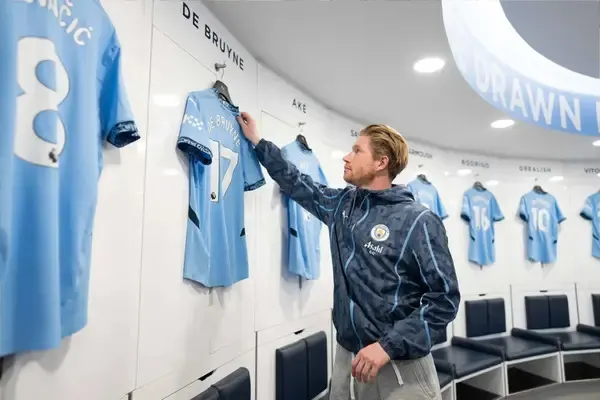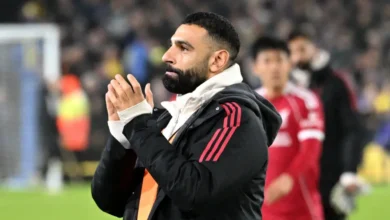Kelvin De Bruyne revealed his next club after reaching full Agreement with rival Club

Kevin De Bruyne’s impending departure from Manchester City was supposed to be a straightforward affair. After nine transformative years at the Etihad Stadium, the Belgian maestro appeared destined for a new adventure in Serie A with Napoli. However, what began as a seemingly clear-cut transfer has evolved into one of the summer’s most complex and intriguing sagas, with implications that extend far beyond a single player’s career decision.
The 33-year-old midfielder, whose contract with Manchester City expired at the end of the 2024-25 season, finds himself at the center of a three-way tug-of-war involving Italian giants Napoli, Major League Soccer outfit Chicago Fire, and surprisingly, potential suitors within the Premier League itself. This unexpected development has sent shockwaves through the football world, raising questions about loyalty, ambition, and the evolving dynamics of modern football transfers.
The Napoli Dream That Began to Unravel
Naples had seemed like the perfect destination for De Bruyne’s next chapter. Fresh from their Serie A triumph, Napoli identified the Belgian international as the cornerstone signing that could elevate them from domestic champions to European contenders. The club’s owner, Aurelio De Laurentiis, known for his hands-on approach and ambitious vision, had personally courted De Bruyne with a package that reportedly made him the highest-paid player in Serie A history.
The courtship reached its zenith during a pivotal 25-minute conversation between De Laurentiis and De Bruyne, where the Napoli president outlined his vision for the club’s future and the central role the midfielder would play in their European aspirations. The Italian media painted a picture of advanced negotiations, with some outlets suggesting that only minor details remained to be ironed out before an official announcement.
However, beneath the surface optimism lay a growing concern that would ultimately derail the move: managerial uncertainty. Antonio Conte’s future at the Stadio Diego Armando Maradona remained shrouded in doubt, despite his successful first season that delivered the Scudetto. The Italian tactician’s demanding nature and history of sudden departures had created an atmosphere of instability that made De Bruyne increasingly uncomfortable about committing his future to the project.
Sources close to the player revealed that while Napoli’s financial offer was indeed the most lucrative on the table, De Bruyne harbored concerns about the club’s long-term sporting direction. The Belgian, who had thrived under Pep Guardiola’s tactical sophistication at Manchester City, wanted assurances about the continuity of the coaching staff and the club’s commitment to playing attractive, possession-based football.
Furthermore, reports from Italy suggested that the negotiations were not as advanced as initially portrayed by the local media. While Napoli had made their intentions clear and presented an impressive financial package, crucial details regarding the length of the contract, performance-related bonuses, and the player’s role within the squad remained unresolved.
The American Dream: Chicago Fire’s Ambitious Pursuit
Simultaneously, Chicago Fire had been quietly building their case for landing one of European football’s most decorated midfielders. The Major League Soccer franchise, backed by significant financial resources and a desire to make a statement signing, viewed De Bruyne as the perfect marquee addition to elevate both their profile and the league’s global standing.
The American option represented more than just a lucrative contract; it offered De Bruyne the opportunity to become a pioneering figure in MLS’s continued growth. The league had successfully attracted established European stars like Lorenzo Insigne, Giorgio Chiellini, and Gareth Bale in recent years, but none possessed De Bruyne’s combination of recent elite-level success and global recognition.
Chicago Fire’s proposal extended beyond the playing field, with discussions reportedly including commercial opportunities, potential ownership stakes in football-related ventures, and a platform to develop youth academies. The package was designed to appeal to De Bruyne’s business acumen and his interest in football development, particularly in emerging markets.
The lifestyle factor also played a significant role in Chicago Fire’s pitch. The move would offer De Bruyne and his family a fresh start in a vibrant city, away from the intense scrutiny of European football. For a player who had spent the majority of his career under the microscope at Chelsea, Wolfsburg, and Manchester City, the prospect of leading a more balanced life while still competing at a high level held considerable appeal.
However, the MLS option also presented challenges. The standard of play, while improving rapidly, remained significantly below Europe’s elite levels. For a perfectionist like De Bruyne, who had built his reputation on competing against the world’s best players week in and week out, the transition to MLS represented a considerable step down in terms of sporting ambition.
The Shocking Premier League Possibility
The most surprising development in the De Bruyne saga emerged from reports suggesting that the Belgian might not leave English football at all. Intelligence from within the transfer market indicated that several Premier League clubs had begun exploring the possibility of securing his services, with Liverpool emerging as the most serious contender.
The potential move to Anfield would represent one of the most controversial transfers in Premier League history, drawing parallels to Carlos Tevez’s contentious switch from Manchester United to Manchester City in 2009. The comparison was particularly apt given De Bruyne’s status as a Manchester City legend and his integral role in their recent success.
Liverpool’s interest in De Bruyne aligned perfectly with Jürgen Klopp’s evolving tactical philosophy and the club’s need for creativity in midfield following the departures of several key players. The German manager had long admired De Bruyne’s versatility, vision, and leadership qualities, viewing him as the ideal addition to complement the club’s high-intensity pressing style with moments of individual brilliance.
From a sporting perspective, the move made considerable sense for both parties. Liverpool’s recent struggles in breaking down defensive opponents had highlighted their need for a player capable of unlocking tight games with a moment of magic. De Bruyne’s track record of delivering in crucial moments, combined with his experience in high-pressure situations, made him an attractive proposition for a club with Champions League and Premier League ambitions.
The financial implications were equally intriguing. As a free agent, De Bruyne would not require a transfer fee, allowing Liverpool to allocate their entire budget toward his wages and signing bonus. While his £400,000-per-week salary at Manchester City made him one of the highest-paid players in world football, Liverpool’s recent commercial success and improved revenue streams made such an investment feasible.
However, the emotional and cultural barriers to such a move were substantial. De Bruyne’s relationship with Manchester City fans had been built over nine years of exceptional service, during which he had become synonymous with the club’s most successful period. The prospect of seeing him in Liverpool colors would be particularly painful for City supporters, who had watched him develop from a talented but inconsistent player into one of the world’s elite midfielders.
The Financial Landscape
The economic aspects of De Bruyne’s potential transfer painted a fascinating picture of modern football’s financial realities. His £400,000-per-week salary at Manchester City had made him the club’s second-highest earner, behind only Erling Haaland’s record-breaking contract. This wage structure reflected not only his on-field contributions but also his commercial value and leadership role within the squad.
For Napoli, matching or exceeding this salary would represent a significant departure from their traditional wage structure. The Serie A champions had historically operated with a more modest payroll compared to Europe’s elite clubs, but their recent success and ambitious ownership had opened the door to more substantial investments in player salaries.
The Chicago Fire package, while potentially lower in basic wages, offered unique benefits that European clubs could not match. The American tax system, combined with MLS’s designated player rules and potential commercial opportunities, could result in a comparable net income for De Bruyne while providing additional long-term financial benefits.
Liverpool’s approach would likely involve a shorter-term, high-value contract that reflected both De Bruyne’s age and the club’s need for immediate impact. The absence of a transfer fee would allow them to front-load the deal with significant signing bonuses and performance-related incentives.
Tactical Considerations and Playing Style
Each potential destination offered De Bruyne different tactical challenges and opportunities that would significantly impact his playing career’s final chapter. At Napoli, he would likely operate in a more advanced role, possibly as a trequartista behind the striker, utilizing his vision and passing range to create opportunities in a more possession-oriented system.
The Serie A style of play, with its emphasis on tactical discipline and strategic patience, would suit De Bruyne’s evolved game perfectly. His experience and football intelligence would be invaluable in navigating the league’s notoriously tight defensive setups, while his dead-ball expertise would add a new dimension to Napoli’s attacking arsenal.
Chicago Fire’s tactical setup would provide De Bruyne with more freedom to dictate games from deeper positions, similar to his role during his peak years at Manchester City. The relatively lower defensive intensity in MLS would allow him to showcase his full range of passing and vision, potentially resulting in spectacular statistical returns that could further enhance his legacy.
A potential move to Liverpool would present the most intriguing tactical proposition. Jürgen Klopp’s system, built on intense pressing and rapid transitions, would require De Bruyne to adapt his game significantly. However, his experience and intelligence suggested he could successfully integrate into Liverpool’s tactical framework while adding the creative spark the team had occasionally lacked in crucial moments.
The Personal Dimension
Beyond the professional considerations, De Bruyne’s decision would inevitably be influenced by personal factors that rarely make headlines but often prove decisive in such situations. His family’s preferences, his children’s education, and his wife’s career aspirations would all play crucial roles in determining his next destination.
The lifestyle differences between Naples, Chicago, and Liverpool (or another English city) were substantial. Naples offered Mediterranean charm, cultural richness, and a slower pace of life that could be appealing for a player entering his thirties. Chicago represented adventure, new experiences, and financial security in a growing football market. Remaining in England would provide continuity, familiar surroundings, and the comfort of established relationships.
De Bruyne’s personality, characterized by professionalism, dedication, and a quiet confidence, suggested he would approach this decision with the same methodical analysis he applied to his on-field performances. His track record of making calculated career moves, from his early departure from Chelsea to his successful stint at Wolfsburg and eventual triumph at Manchester City, indicated he would prioritize long-term satisfaction over short-term gains.
Historical Precedents and Industry Impact
The De Bruyne transfer saga occurred against the backdrop of several significant precedents in modern football transfers. The success of veterans like Cristiano Ronaldo at Al-Nassr, Karim Benzema at Al-Ittihad, and various stars in MLS had demonstrated that elite players could maintain high performance levels while exploring new markets and challenges.
However, De Bruyne’s situation was unique in several respects. Unlike players who moved to Saudi Arabia or MLS after clearly declining performances, he remained at the peak of his powers, having delivered another exceptional season for Manchester City. His potential availability as a free agent made him an even more attractive proposition for clubs across different leagues and continents.
The transfer’s potential impact on the broader football landscape could be substantial. A move to Napoli would signal Serie A’s continued resurgence as a destination for world-class talent, potentially encouraging other elite players to consider Italian football. His arrival in MLS would represent the league’s biggest signing to date in terms of current ability and global profile, potentially accelerating the competition’s growth and international recognition.
Most significantly, a move to Liverpool or another Premier League rival would challenge traditional notions of club loyalty and player movement within England’s top flight. While such transfers had occurred before, De Bruyne’s status as a Manchester City legend would make his departure particularly poignant and controversial.
The Broader Context of Modern Football
De Bruyne’s transfer situation reflected broader trends in contemporary football that extended beyond individual career decisions. The increasing globalization of the sport had created unprecedented opportunities for players to explore different leagues, cultures, and challenges throughout their careers.
The financial dynamics of modern football had also evolved significantly, with clubs in previously secondary leagues now capable of competing for elite talent through substantial financial investments. This democratization of the transfer market had created more options for players while forcing traditional powerhouses to work harder to retain their stars.
Furthermore, the changing attitudes toward career longevity and life balance among professional athletes had influenced how players approached major career decisions. The old model of playing for one or two clubs throughout an entire career had given way to a more fluid approach that prioritized new experiences, personal growth, and diverse challenges.
Looking Ahead: The Decision’s Implications
As De Bruyne weighed his options, the football world watched with anticipation and curiosity. His decision would not only determine his own legacy but could also influence how other elite players approached similar crossroads in their careers.
The Belgian’s choice would inevitably be scrutinized for years to come, regardless of which path he chose. A successful stint at Napoli could inspire other Premier League stars to test themselves in Serie A, while a thriving period in MLS might encourage more elite players to view American soccer as a legitimate competitive option rather than merely a lucrative retirement destination.
Perhaps most intriguingly, a decision to remain in the Premier League would send shockwaves through English football, challenging assumptions about player loyalty, competitive ethics, and the boundaries of acceptable transfers within the league.
Conclusion: A Defining Moment
Kevin De Bruyne’s transfer saga represented more than just another high-profile player move; it embodied the complex realities of modern football, where sporting ambition, financial considerations, personal preferences, and global opportunities intersected in unprecedented ways.
Whatever decision the Belgian maestro ultimately made, it would mark the end of one of the most successful chapters in Manchester City’s history and the beginning of a new adventure that could redefine the final years of one of football’s most gifted players.
The coming weeks would reveal not just De Bruyne’s destination, but also provide insights into the evolving nature of football transfers, player motivations, and the global game’s continued transformation. In an era where the unexpected had become routine, De Bruyne’s next move promised to add another fascinating chapter to football’s ever-evolving narrative.
As the summer transfer window progressed, one thing remained certain: wherever Kevin De Bruyne chose to continue his illustrious career, his decision would be remembered as a pivotal moment that reflected the beautiful game’s endless capacity for surprise, controversy, and reinvention.















